Wireless LANs or how Wi-Fi works according to the IEEE 802.11 standard. Lab at Packet Tracer
- Tutorial
Introduction
In this article, laboratory technology studies the technology of wireless local area networks according to the IEEE 802.11 standard. The IEEE standard was developed by the Institute of Electrical and Electronic Engineers. From here he got his name. This standard defines Ethernet local area networks; therefore, the TCP / IP model does not define Ethernet networks in its comment requests, but refers to IEEE Ethernet documents. All work will be performed in the Cisco Packet Tracer program.

Wireless networking concept
Many users regularly use the services and devices of wireless local area networks (Wireless LAN - WLAN). Currently, there is a growing tendency to use portable devices such as laptops, tablets, smartphones. Also, the concepts of a “smart home” are actively developing, most of the devices of which are connected “over the air”. In this regard, there was a need for a wireless connection in all crowded places: at work, at home, in a hotel, in a cafe or bookstore. With the growing number of wireless devices that connect via WLAN, the popularity of wireless networks has grown.
Below is a simplified diagram of the network in the “Book House” on Nevsky Prospekt in St. Petersburg.
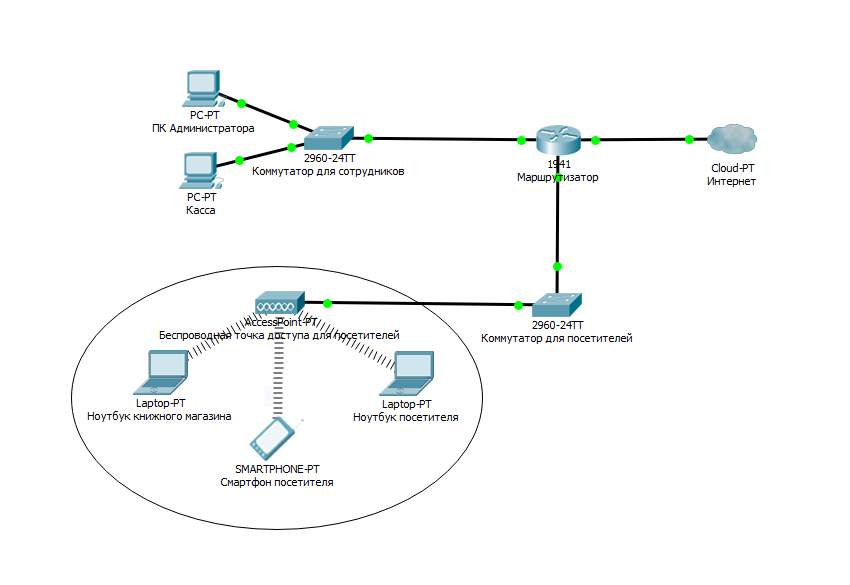
Visitor laptops communicate with a WLAN device called a wireless access point. The access point uses a radio channel to send and receive frames (separate, finished HTML documents that, together with other HTML documents can be displayed in a browser window) from a client device, such as a computer. In addition, the access point is connected to the same Ethernet network as the devices that support the store, therefore, both customers and employees can search for information on remote websites.
Comparing Wireless LANs with Local Area Networks
Wireless LANs are very similar to LANs, for example, both types of networks allow devices to communicate with each other. For both types of networks, the IEEE standard works (IEEE 802.3 for Ethernet networks and 802.11 for wireless networks). Both standards describe the format of network frames (header and trailer), it is indicated that the header should be 6 bytes long and contain the MAC addresses of the sender and receiver. Both standards indicate exactly how devices on the network should determine when a frame can be sent to the environment, and when not.
The main difference between the two types of networks is that for the transmission of data in wireless networks, the technology of radiation of energy (or the technology of emission of radio waves) is used, and in Ethernet networks, the transmission of electrical pulses through a copper cable (or light pulses in an optical fiber) is used. To transmit radio waves, a special working environment is not needed, they usually say that “communication takes place through the air” in order to emphasize that no physical network is needed. In fact, any physical objects in the path of the radio signal (walls, metal structures, etc.) are an obstacle that degrades the quality of the radio signal.
Wireless LAN Standards
IEEE defines four basic 802.11 WLAN standards: 802.11a, 802.11b, 802.11g, and 802.11n.
The following four organizations had the greatest impact on wireless standards (see table below)
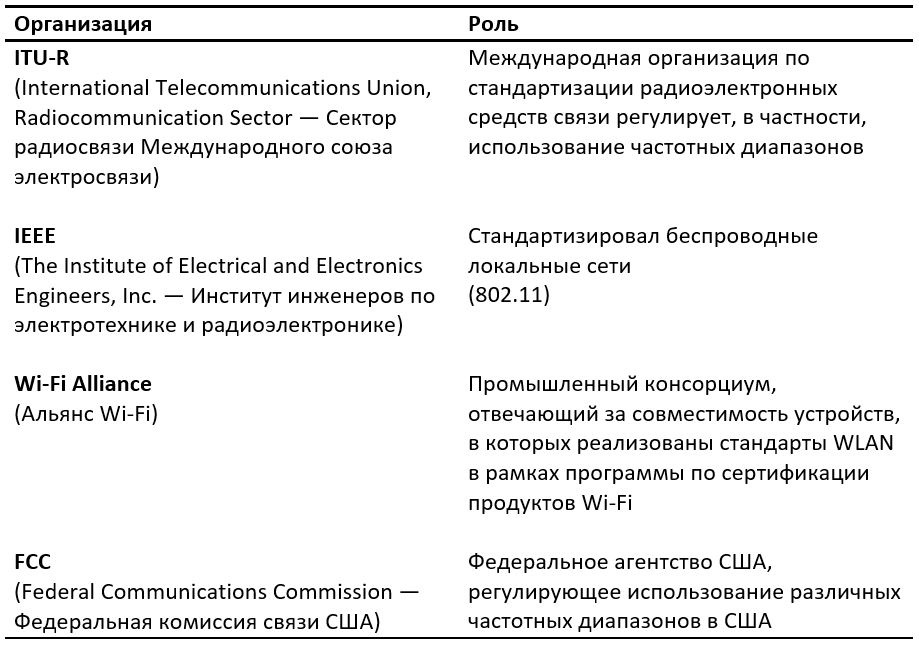
Comparison of WLAN standards

In addition to the main standards from the table, there are additional standards that are listed below.
There are also two recommendations. The letters are capitalized.
• 802.11F - Inter-Access Point Protocol (service information exchange protocol for transferring data between access points. This protocol is a recommendation that describes the optional IEEE 802.11 extension that provides a wireless access point for communication between systems of different manufacturers).
• 802.11T - Wireless Performance Prediction (WPP, prediction of the performance of wireless equipment) - test and measurement methods (the method is a set of methods recommended by IEEE for testing 802.11 networks: methods for measuring and processing results, requirements for test equipment).
Key devices and symbols for working with Wi-Fi
1. An access point is a wireless “extension cord” of a wired network

2. A router is a more “smart” device that not only receives and transmits data, but also redistributes them according to various established rules and executes the given commands.

3. Cloud - configured part of the network

4. Wi-Fi connection

5. Direct line - cable (twisted pair)
Basic ways to use Wi-Fi
1. Wi-Fi bridge - connecting two access points via Wi-Fi

2. Wi-Fi router - Connect all devices to the router via Wi-Fi (the entire network is connected wirelessly).
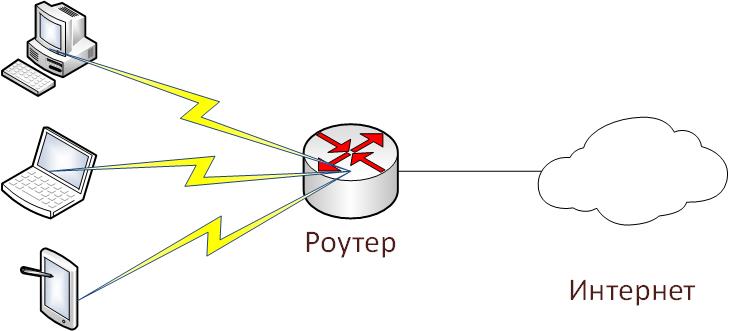
3. Wi-Fi hotspot- connecting part of the network for wireless work
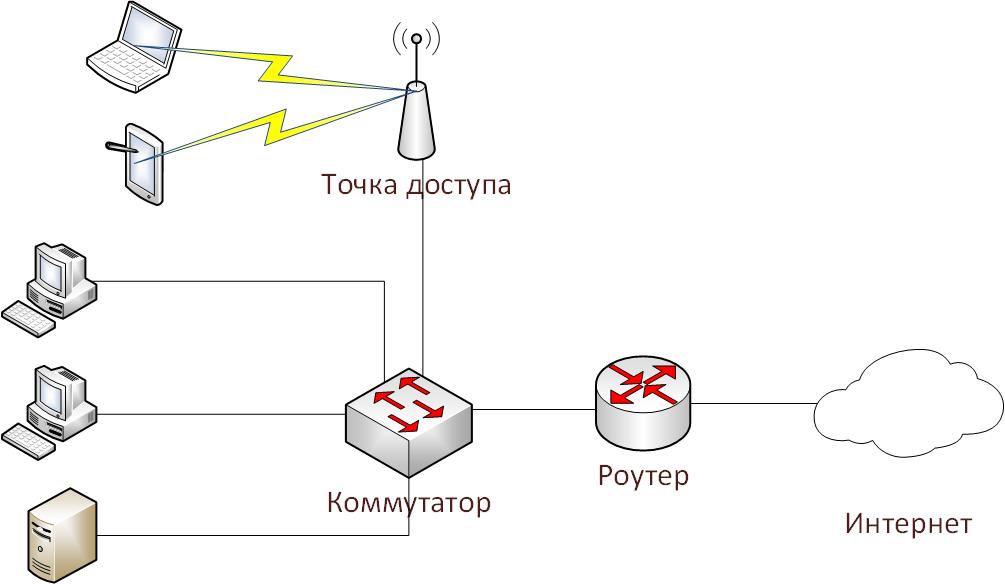
Lab tasks.
1. Create and configure a second and third use case for Wi-Fi in the Cisco Packet Tracer.
2. Set up a bridge between two access points (the first option to use Wi-Fi) on real equipment.
Laboratory work.
Task No. 1 (network option No. 2)
1. Create a Wi-Fi router on the Packet Tracer workspace (aka Wi-Fi router)

2. Create a router from the provider (for example, the name of the provider is “Miry-Mir”). I chose the Cisco 1841 router.

3. Connect them with a cross-cable (dashed line), since the devices are of the same type (routers). We connect this way: one end in Router1 in FastEthernet 0/0, and the other end in Wireless Router0 in the Internet connector, since Router1 gives us the Internet.

4. Set up an Internet router (Router1) to work with the network. To do this, go to the router settings by double-clicking on it and go to the CLI tab (Command Line Interface).
In the “Would you like to enter the initial configuration dialog? [yes / no]: "(you want to enter the initial configuration dialog) write" no ".
We write the following sequence of commands: By tradition, consider them in order.
Connection established.

5. Set up a wireless router (Wireless Router0) to work with the network. To do this, as in the case of the previous router, let's go to the router settings by double-clicking on it. In the tabs, select the graphical user interface (GUI). This mode will be displayed when you enter the router address in any browser.
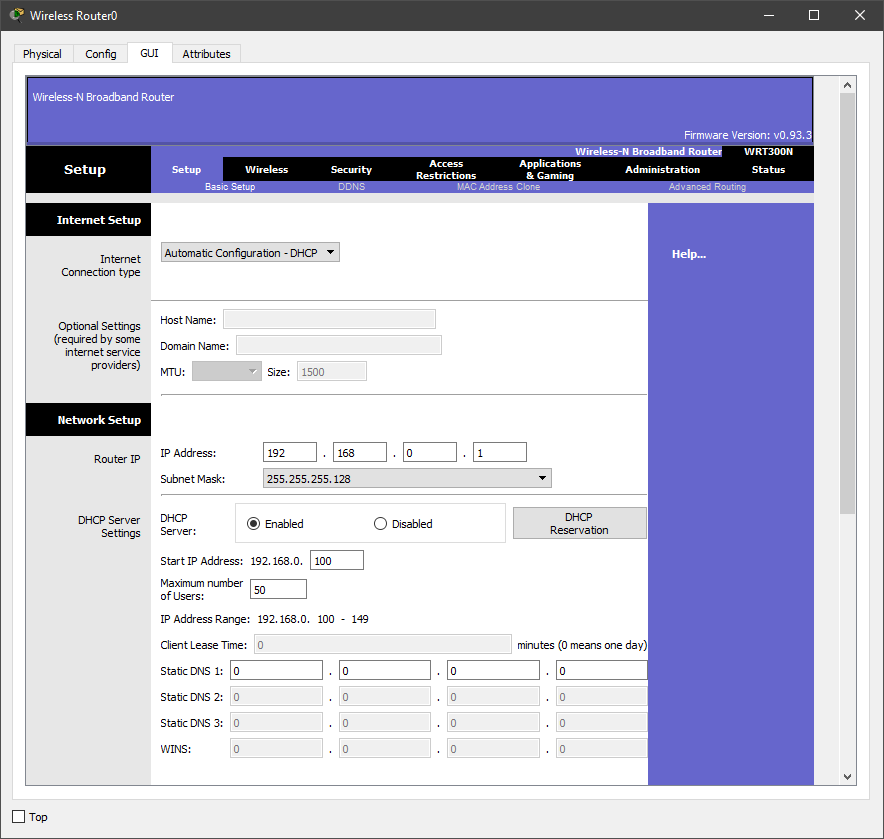
Set the following settings: And at the bottom of the page, click the “Save settings” button . Analysis of the settings: We selected a static IP, as the provider gave us a white IP address (120.120.0.1/24). The default path (Default Gateway) is the address of the router from the provider. The address of the router from the side of wireless devices is 192.168.0.1/24. The router will distribute IP from 100 to 150.
6. Go to the Wireless tab, that is, the wireless connection.
We set the following settings: And at the bottom of the page, click the “Save settings” button . Analysis of the settings:
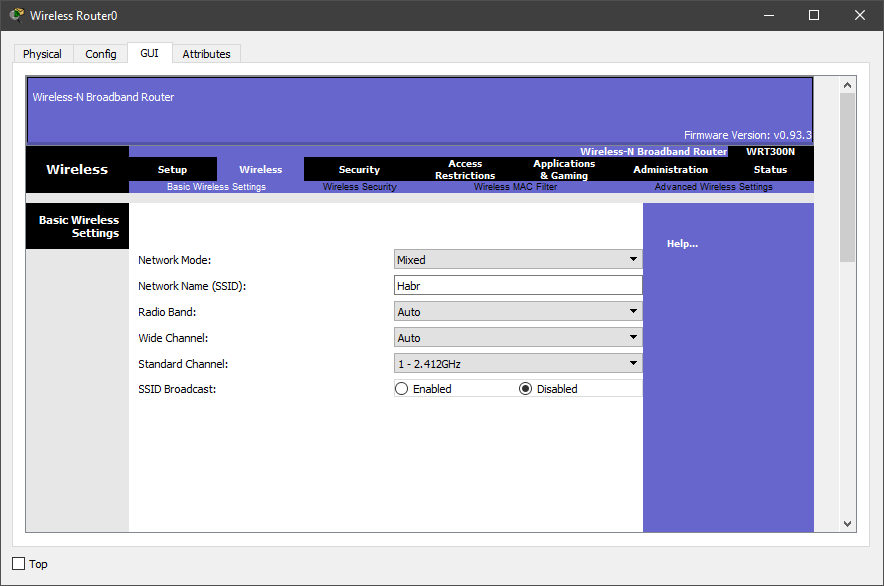
7. Set up the protection of our router. To do this, go to the Security tab and select “WPA2 Personal” in the “Security Mode” item, since WPA is a vulnerable protection. Choosing WPA2 Enterprise is also not worth it, because for it to work, we need a radius server that we did not deal with. We leave the encryption algorithm AES and enter the code word. I set Habrahabr.
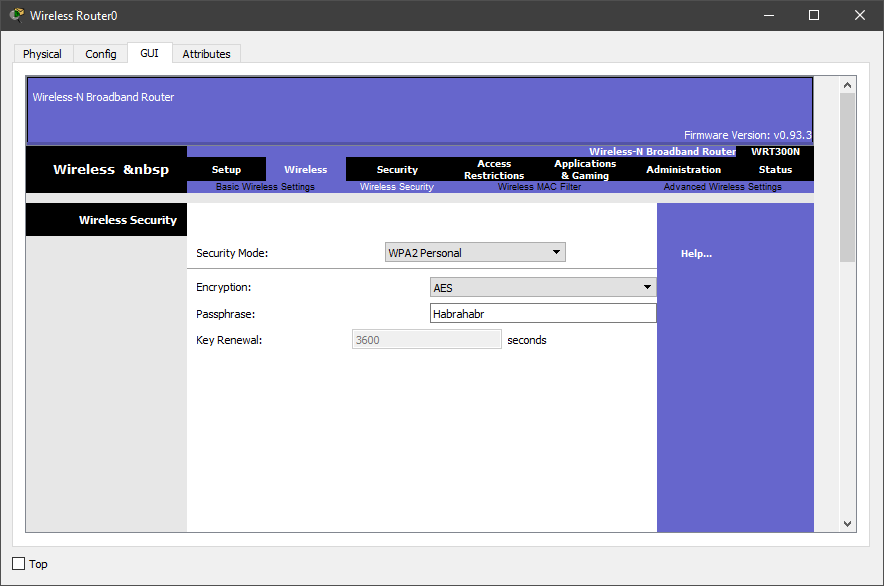
8. Add 3 devices, as in the diagram (smartphone, laptop and computer). Then we replace the connectors for rj-45 with a Wi-Fi antenna (in the smartphone, the antenna is by default).
9. In the Config tab, set the settings that were set on the router. This operation must be done on all devices.
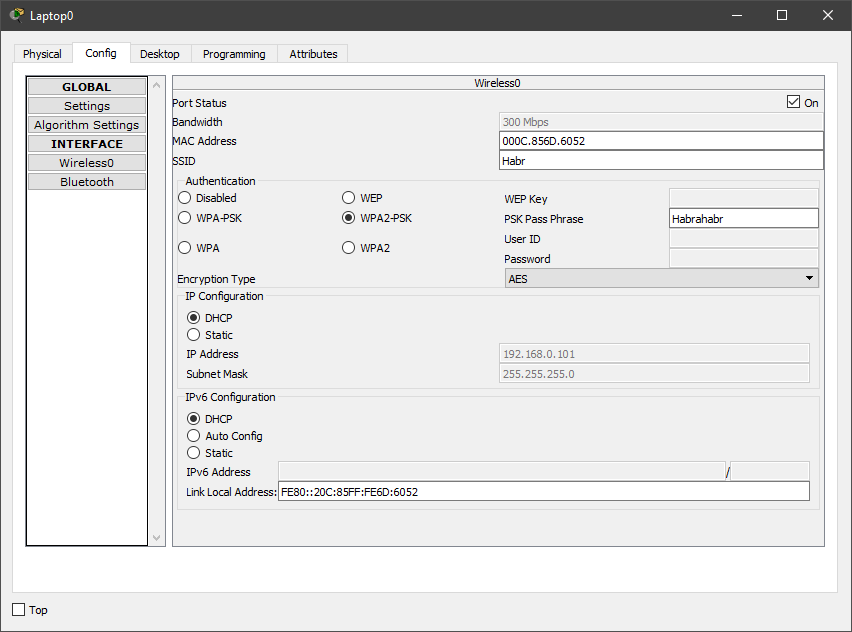
10. Go to the desktop of any computer and open the command line.
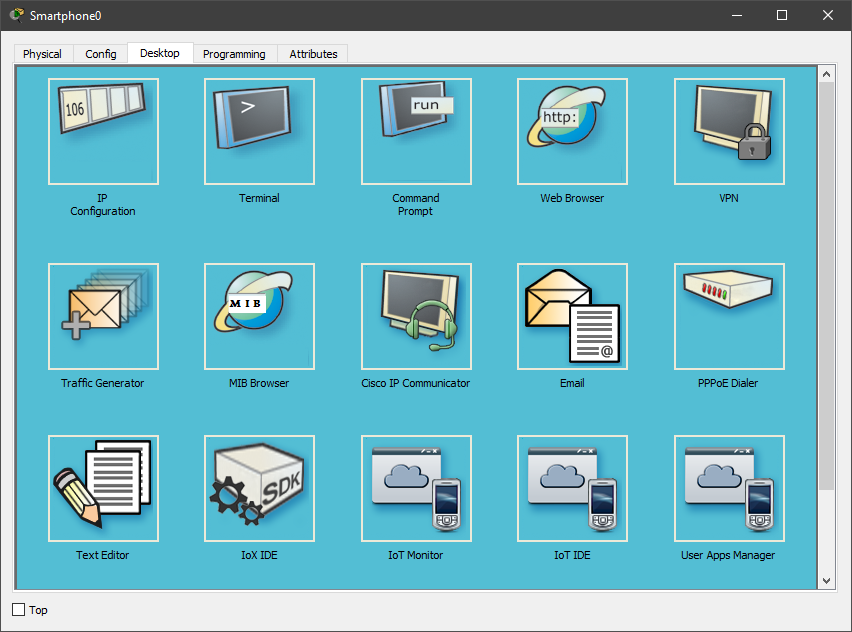
11. Check what addresses the router issued to the devices. To do this, enter the ipconfig command.
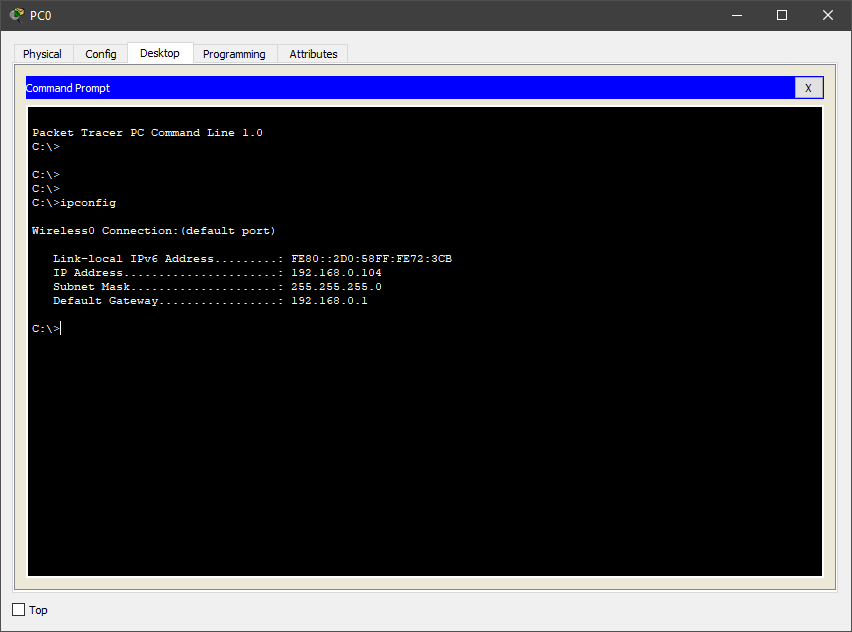
As you can see in the screenshot, the router issues addresses from 192.168.0.100 to 192.168.0.150.
12. Check the network performance from any device using the ping command. We will ping 2 addresses - the address of the router (192.168.0.1) and the white address (120.120.0.1), that is, we will check whether the device can access the Internet.
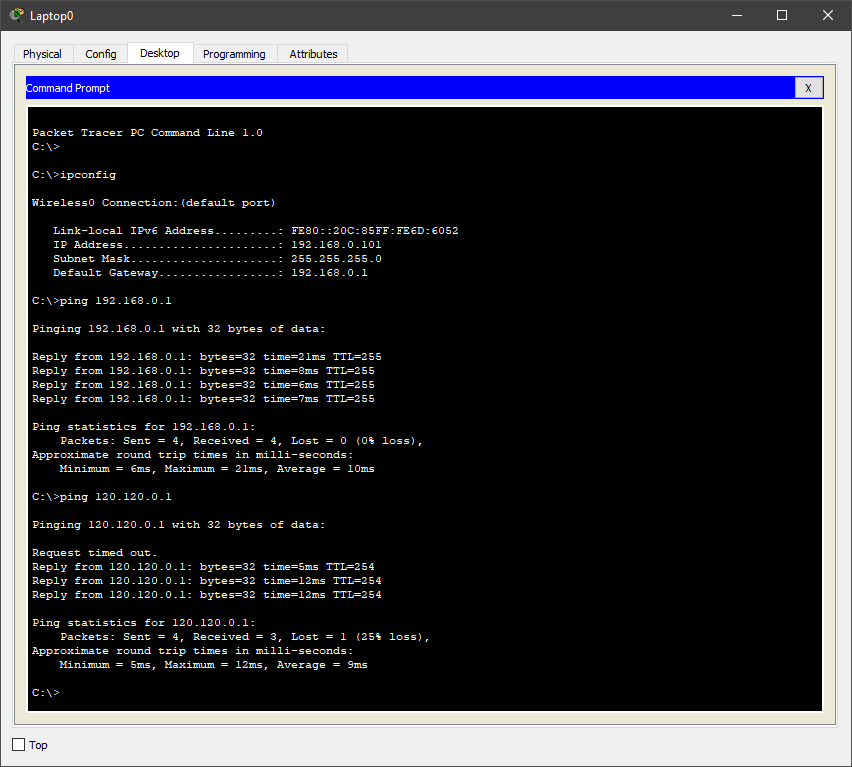
Again, everything works.
As a result, we got a Wi-Fi network, which is shown in the second use case.

Task No. 1 (network option No. 3)
1. Open the finished project from the previous laboratory work on PAT.
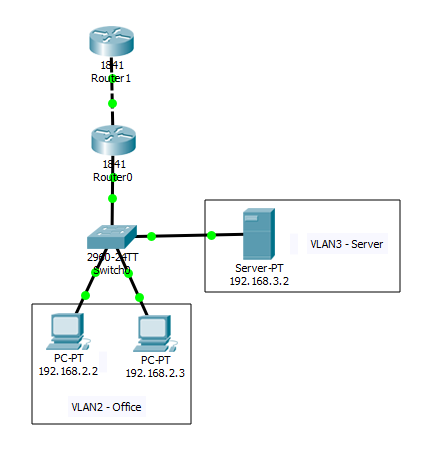
2. Create an access point on the working field of the program and connect it to the switch. If desired, you can configure the access point (Port 0 is the physical port, and Port 1 is the wireless one)
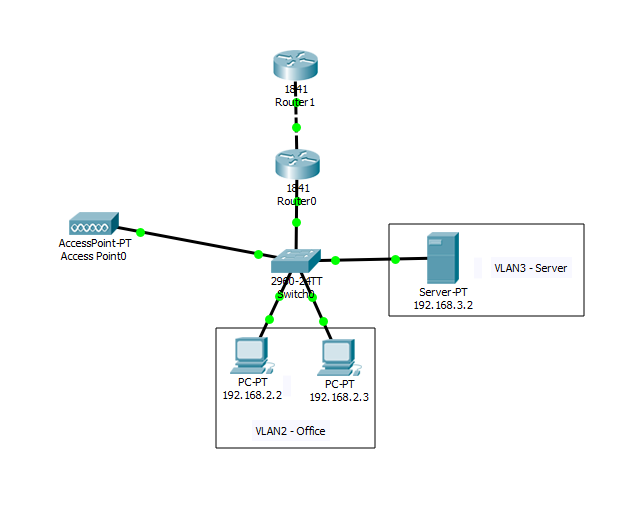
3. Create another VLAN for the wireless access point.
4. Add 0 VLAN 4 in the settings of the router, and also add it to the access list to access the Internet.
Since we did this in previous laboratory work (on VLAN and PAT ), I won’t stop in detail, but I will write down all the commands on the
Switch Router devices (subinterface)
Router (DHCP (Dynamic Host Configuration Protocol - Dynamic Host Configuration Protocol). A network protocol that allows computers to automatically obtain the IP address and other parameters necessary for working in a TCP / IP network) Here I will dwell in more detail, since we have not seen this data before parameter.
Router (access list) Add a smartphone to the Packet Tracer workspace and ping the PC, server and the Internet, that is, 192.168.2.2, 192.168.3.2, 120.120.53.1. Apparently, everything works. Task # 2 (network option # 1) Unfortunately, in Packet Tracer there is no way to create a Wi-Fi bridge (it's a repeater or repeater), but we will do this simple action on real equipment in a graphical environment. The equipment on which the settings will be made is the ASUS RT-N10 router and the so-called TP-LINK TL-WA850RE repeater. Let's move on to setting up the Asus router. To do this, open the browser and enter the address of the router (by default it will open itself) Go to the “Wireless Network” tab and set the setting as in the screenshot below.
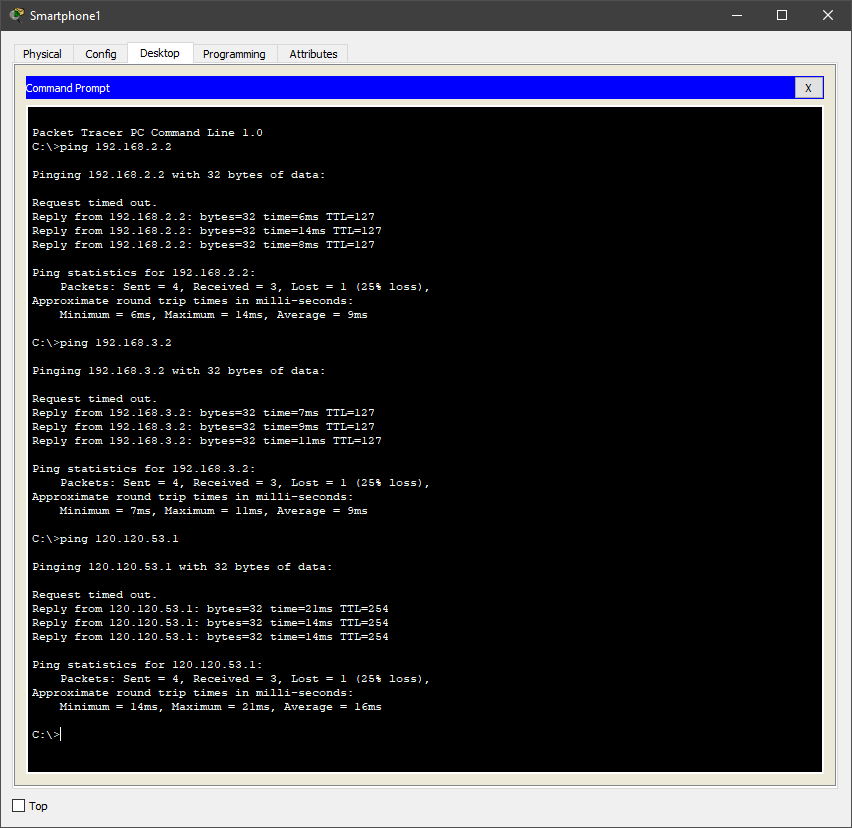
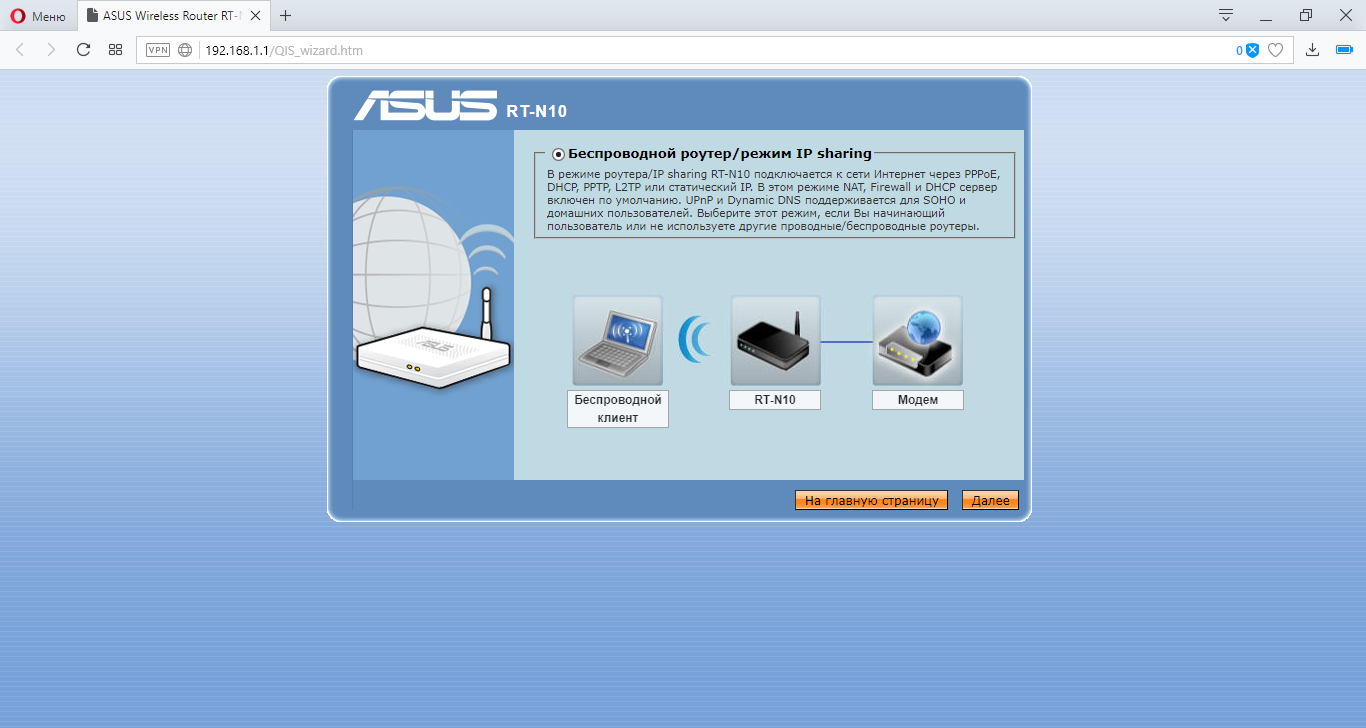
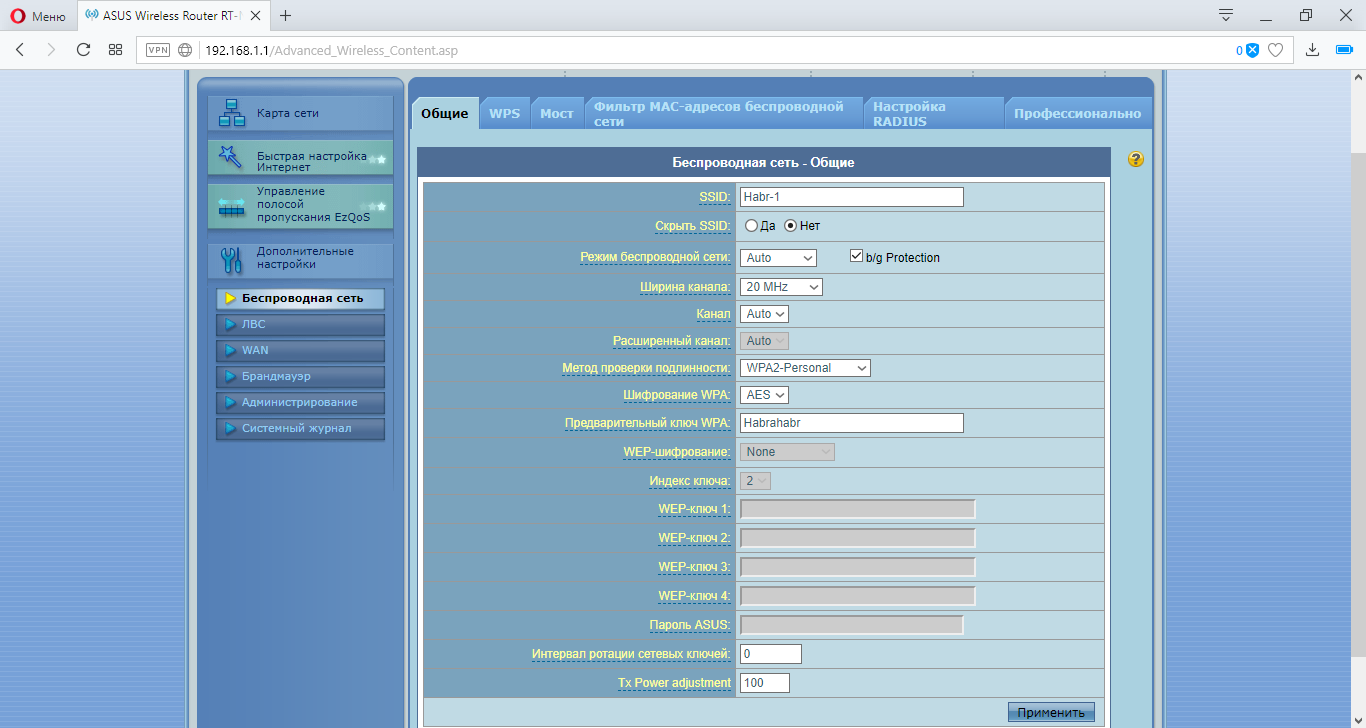
Go to the “LAN” tab (local area network) and set the following settings.

Go to the main tab. There we can see our MAC address.
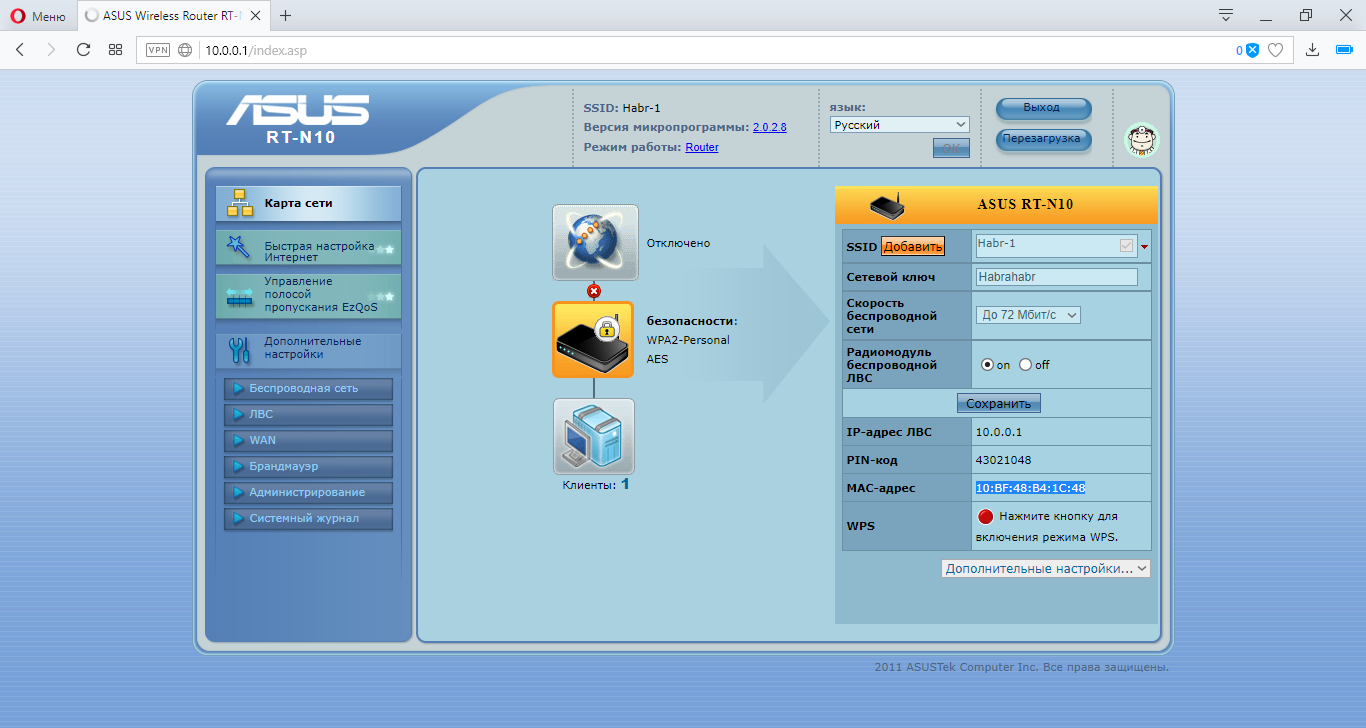
We proceed to setting up the TP-LINK repeater. The
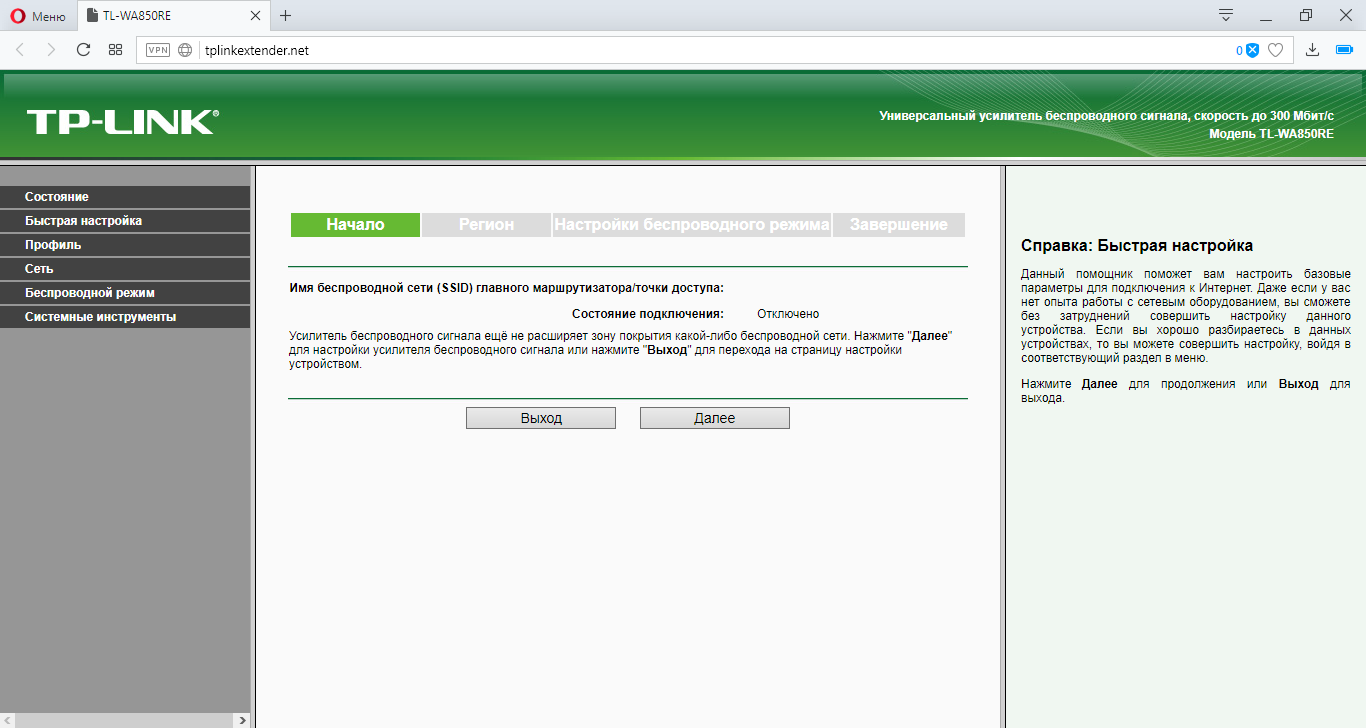
device will automatically give us the main menu and quick setup mode. Click "Exit" and configure yourself.
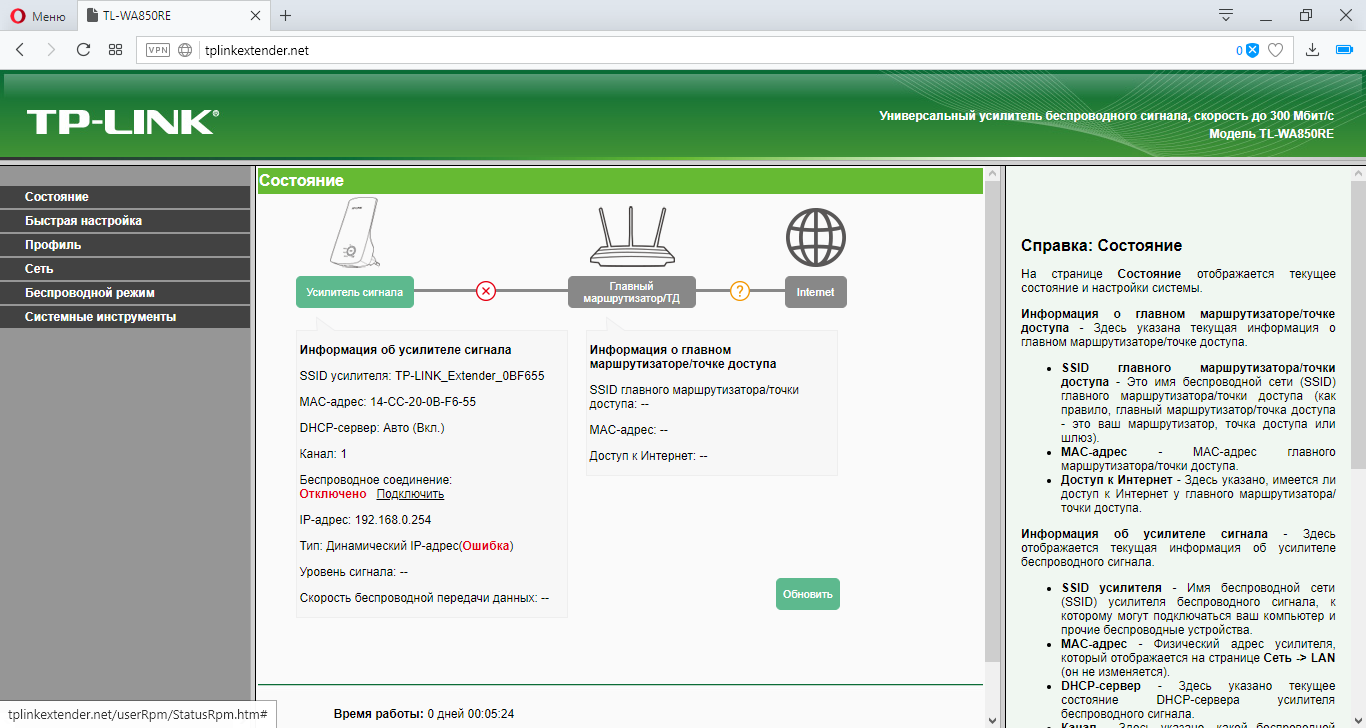
Go to the “Network” tab and set the following settings.
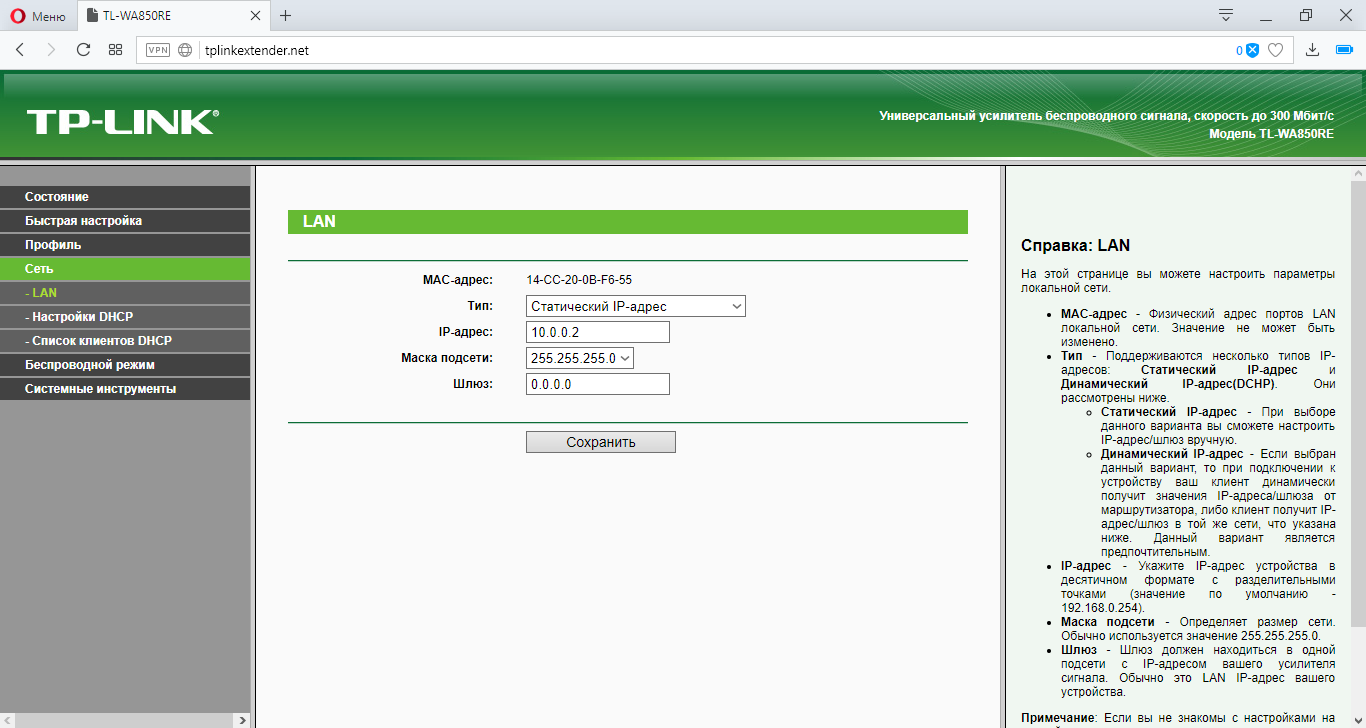
Go to the tab "Wireless Mode" and configure the input and output stream.

In the “Profile” tab, we see all the profiles that we created. Click the “Change” button. Configure the
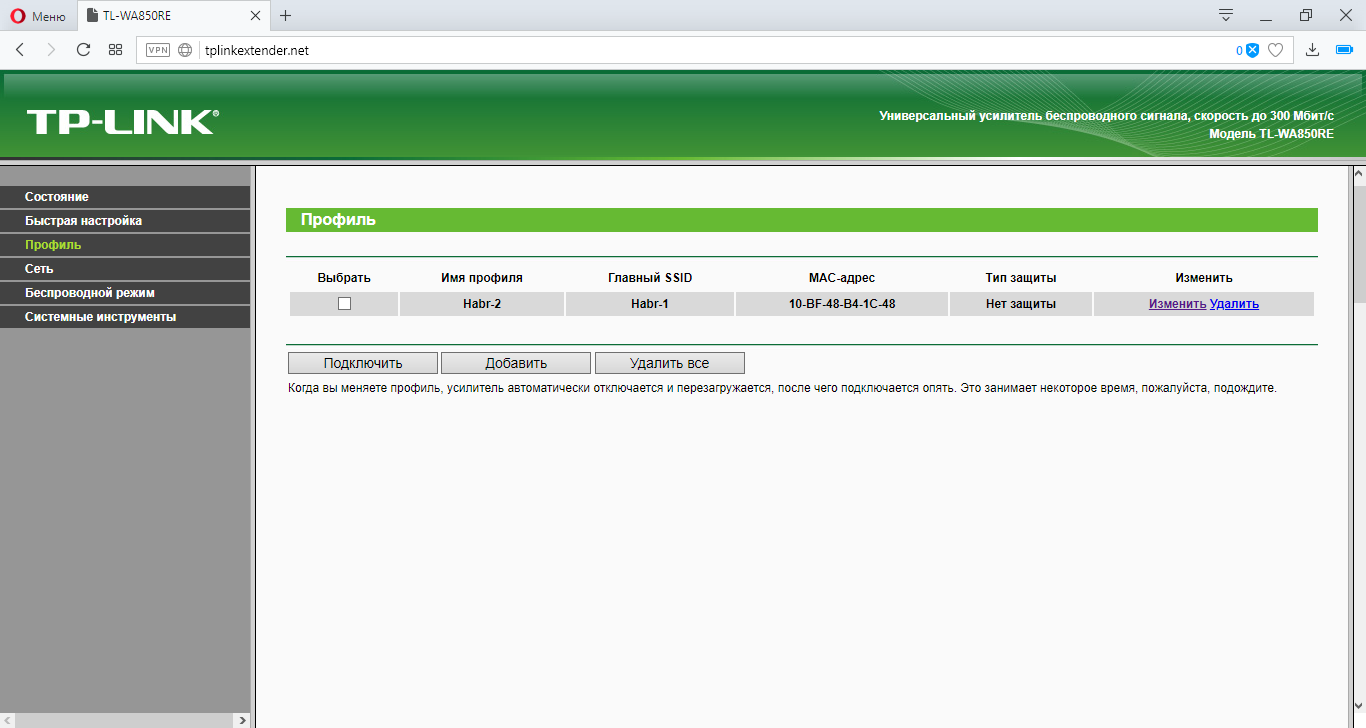
security of the output network by adding the WPA2 key.
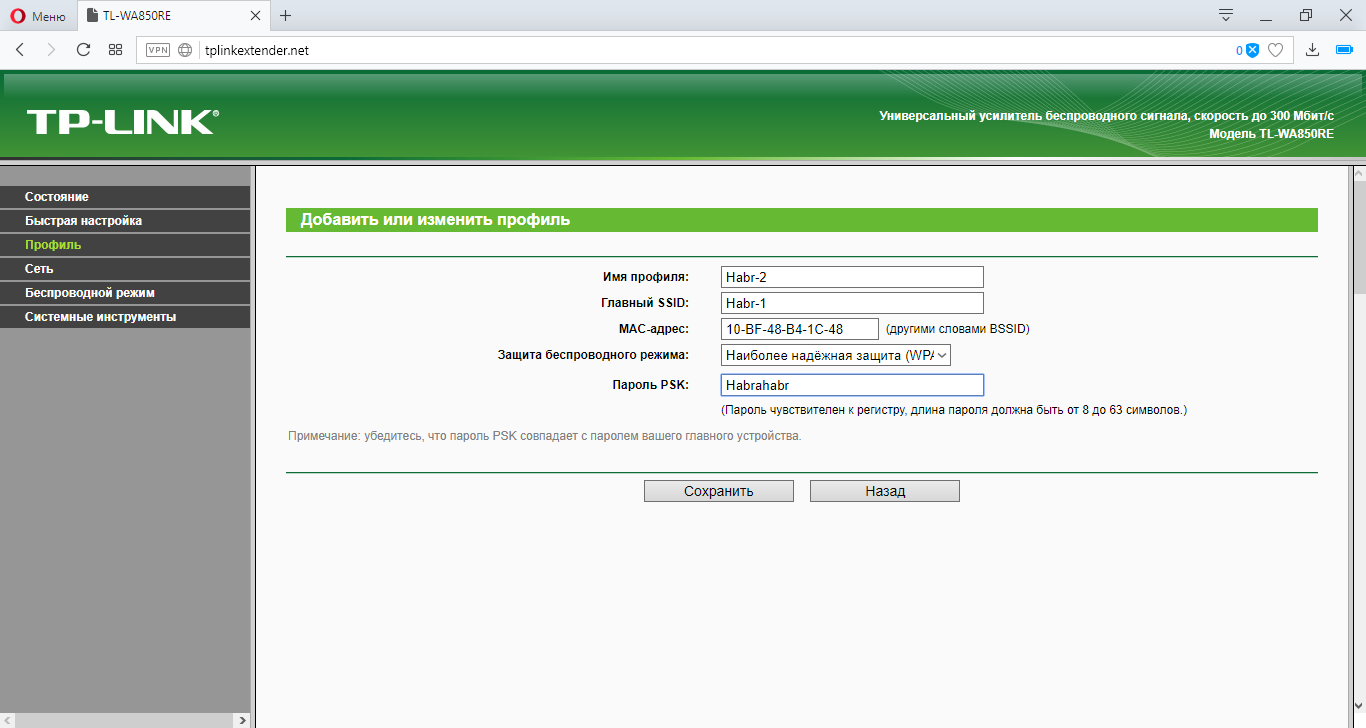
Go to the main menu and select the "Connect" in the "Wireless Connection". Next will be the configuration of the bridge. You may need to enter the password from the Asus router.

After clicking the button, the configuration will be loaded

And voila! All is ready!

In order not to get confused by which device to connect, you can hide the SSID on the Asus router. We
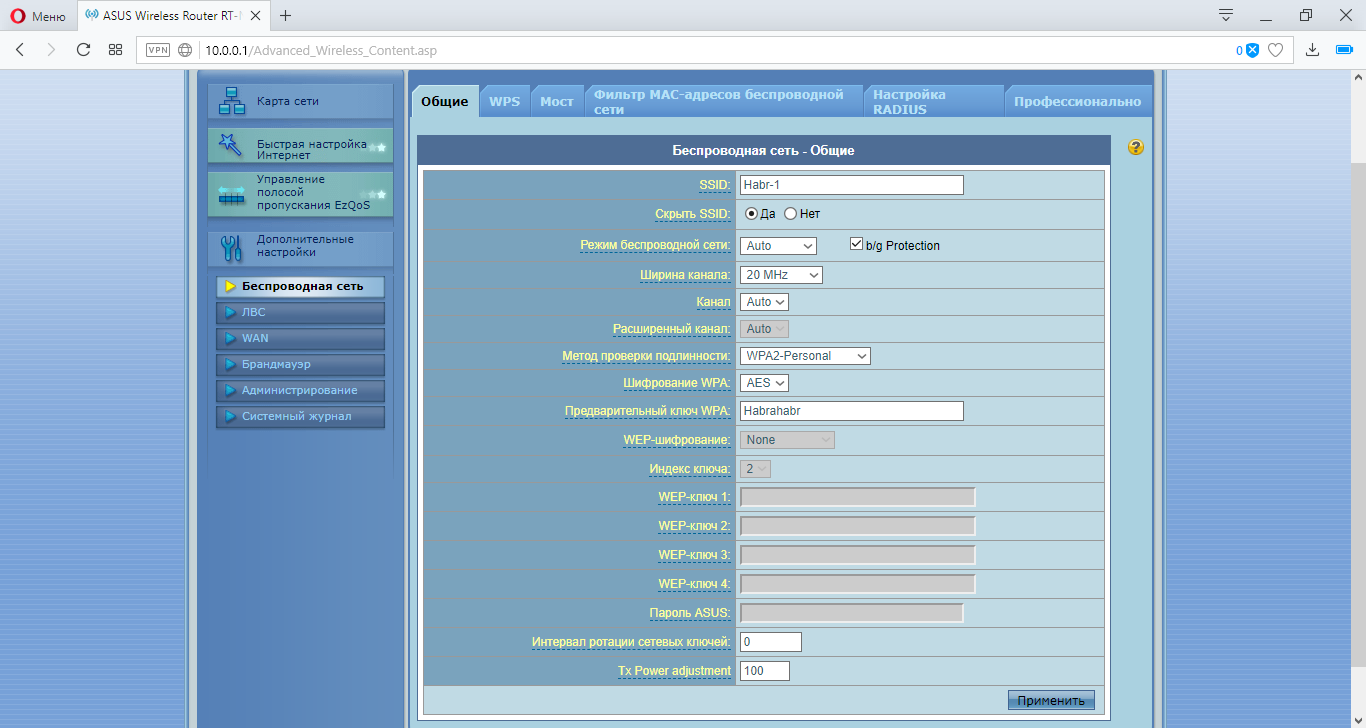
check the cable connection
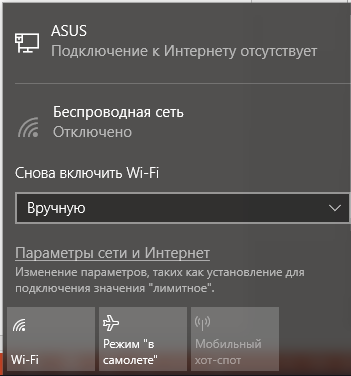
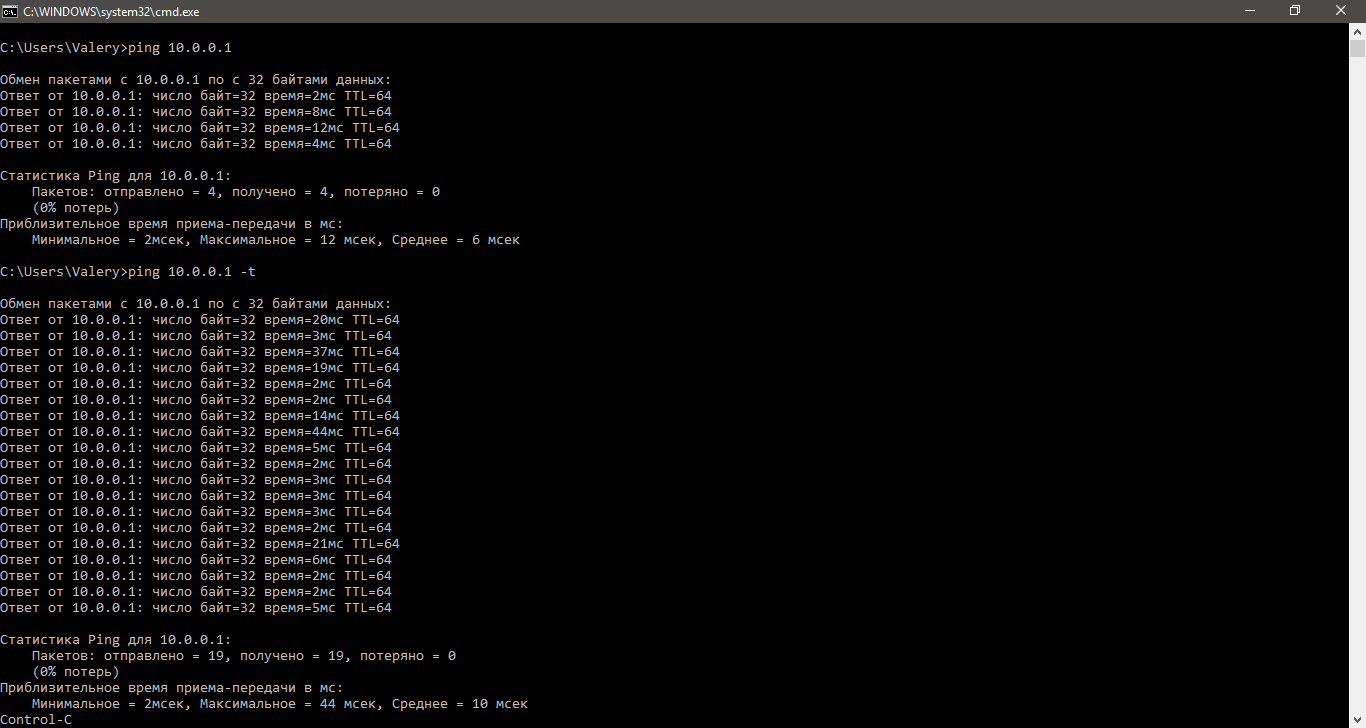
. Ping is successful.
Check over Wi-Fi.
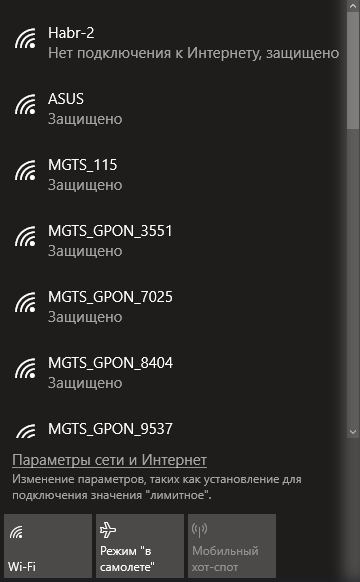
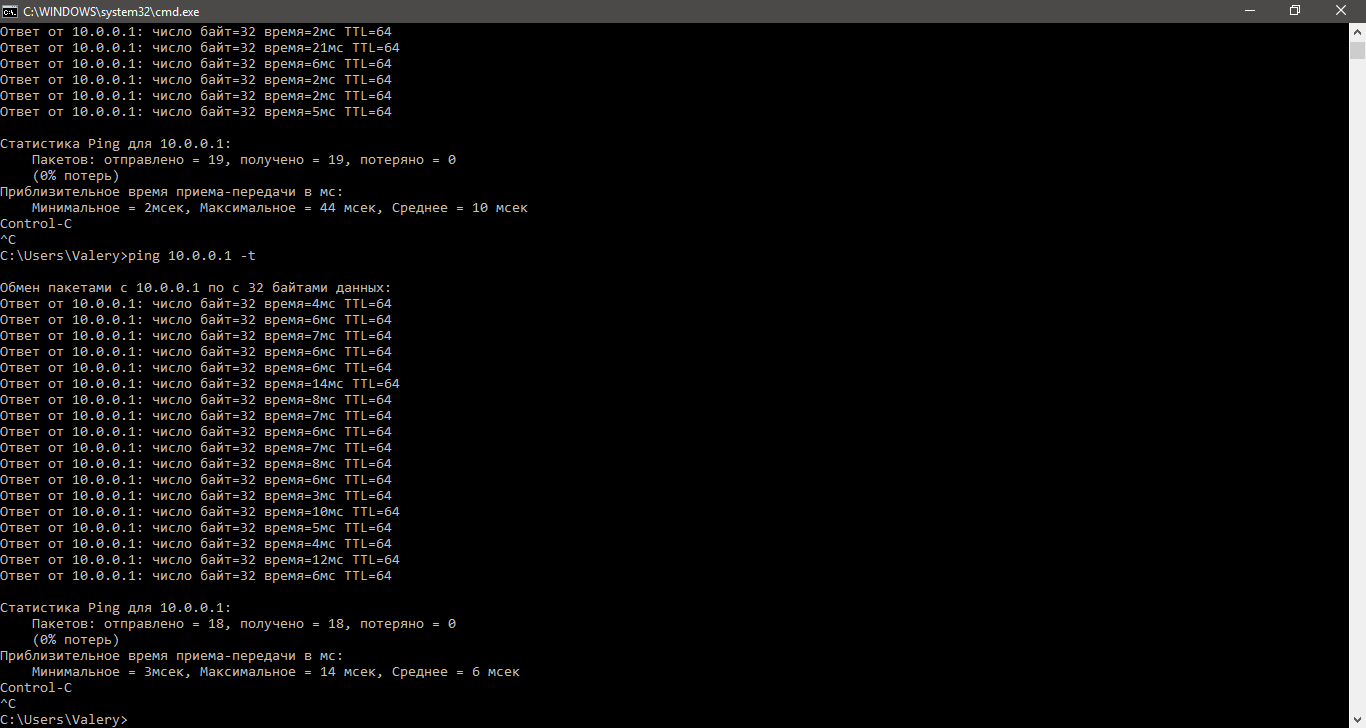
Successfully.
And look at the final configuration, when connected to the repeater.
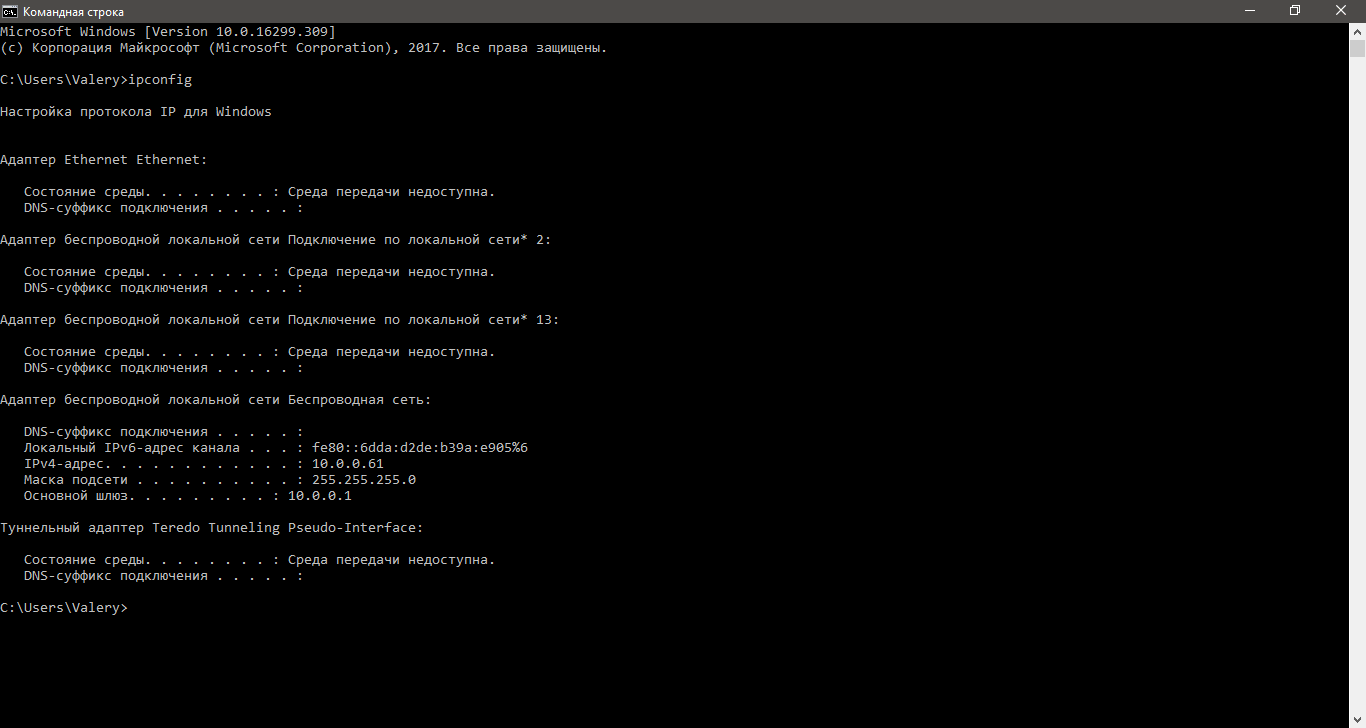
In this article, laboratory technology studies the technology of wireless local area networks according to the IEEE 802.11 standard. The IEEE standard was developed by the Institute of Electrical and Electronic Engineers. From here he got his name. This standard defines Ethernet local area networks; therefore, the TCP / IP model does not define Ethernet networks in its comment requests, but refers to IEEE Ethernet documents. All work will be performed in the Cisco Packet Tracer program.

Wireless networking concept
Many users regularly use the services and devices of wireless local area networks (Wireless LAN - WLAN). Currently, there is a growing tendency to use portable devices such as laptops, tablets, smartphones. Also, the concepts of a “smart home” are actively developing, most of the devices of which are connected “over the air”. In this regard, there was a need for a wireless connection in all crowded places: at work, at home, in a hotel, in a cafe or bookstore. With the growing number of wireless devices that connect via WLAN, the popularity of wireless networks has grown.
Below is a simplified diagram of the network in the “Book House” on Nevsky Prospekt in St. Petersburg.

Visitor laptops communicate with a WLAN device called a wireless access point. The access point uses a radio channel to send and receive frames (separate, finished HTML documents that, together with other HTML documents can be displayed in a browser window) from a client device, such as a computer. In addition, the access point is connected to the same Ethernet network as the devices that support the store, therefore, both customers and employees can search for information on remote websites.
Comparing Wireless LANs with Local Area Networks
Wireless LANs are very similar to LANs, for example, both types of networks allow devices to communicate with each other. For both types of networks, the IEEE standard works (IEEE 802.3 for Ethernet networks and 802.11 for wireless networks). Both standards describe the format of network frames (header and trailer), it is indicated that the header should be 6 bytes long and contain the MAC addresses of the sender and receiver. Both standards indicate exactly how devices on the network should determine when a frame can be sent to the environment, and when not.
The main difference between the two types of networks is that for the transmission of data in wireless networks, the technology of radiation of energy (or the technology of emission of radio waves) is used, and in Ethernet networks, the transmission of electrical pulses through a copper cable (or light pulses in an optical fiber) is used. To transmit radio waves, a special working environment is not needed, they usually say that “communication takes place through the air” in order to emphasize that no physical network is needed. In fact, any physical objects in the path of the radio signal (walls, metal structures, etc.) are an obstacle that degrades the quality of the radio signal.
Wireless LAN Standards
IEEE defines four basic 802.11 WLAN standards: 802.11a, 802.11b, 802.11g, and 802.11n.
The following four organizations had the greatest impact on wireless standards (see table below)

Comparison of WLAN standards

Terms
- DSSS (Direct sequence spread spectrum - Direct sequence method for spreading the spectrum)
- OFDM (Orthogonal frequency-division multiplexing - Orthogonal frequency division multiplexing)
- OFDM (Orthogonal frequency-division multiplexing - Orthogonal frequency division multiplexing)
In addition to the main standards from the table, there are additional standards that are listed below.
Additional Standards
• 802.11 - the original 1 Mbit / s and 2 Mbit / s, 2.4 GHz and IR standard (1997).
• 802.11c - procedures for operations with bridges; included in the IEEE 802.1D (2001) standard.
• 802.11d - international roaming extensions (2001).
• 802.11e - improvements: QoS, packet bursting (2005).
• 802.11h - distributed over the spectrum of 802.11a (5 GHz) for compatibility in Europe (2004).
• 802.11i - Advanced Security (2004).
• 802.11j - extensions for Japan (2004).
• 802.11k - improvements in the measurement of radio resources.
• 802.11l- reserved.
• 802.11m - corrections and corrections for the entire group of 802.11 standards.
• 802.11o - reserved.
• 802.11p - WAVE - Wireless Access for the Vehicular Environment.
• 802.11q - reserved, sometimes confused with 802.1Q.
• 802.11r - fast roaming.
• 802.11s - ESS Wireless mesh network [en] (Extended Service Set - an expanded set of services; Mesh Network - a multiply connected network).
• 802.11u - interoperability with non-802 networks (eg, cellular).
• 802.11v- management of wireless networks.
• 802.11w - Protected Management Frames (protected management frames).
• 802.11x - reserved and will not be used. Not to be confused with the IEEE 802.1X access control standard.
• 802.11y - an additional communication standard operating at frequencies of 3.65-3.70 GHz. It provides speeds of up to 54 Mbps at a distance of up to 5000 m in open space.
• 802.11ac is the new IEEE standard. The data transfer rate is up to 6.77 Gbit / s for devices with 8 antennas. Approved in January 2014.
• 802.11ad- A new standard with an additional range of 60 GHz (frequency does not require licensing). Data transfer rate - up to 7 Gb / s
• 802.11c - procedures for operations with bridges; included in the IEEE 802.1D (2001) standard.
• 802.11d - international roaming extensions (2001).
• 802.11e - improvements: QoS, packet bursting (2005).
• 802.11h - distributed over the spectrum of 802.11a (5 GHz) for compatibility in Europe (2004).
• 802.11i - Advanced Security (2004).
• 802.11j - extensions for Japan (2004).
• 802.11k - improvements in the measurement of radio resources.
• 802.11l- reserved.
• 802.11m - corrections and corrections for the entire group of 802.11 standards.
• 802.11o - reserved.
• 802.11p - WAVE - Wireless Access for the Vehicular Environment.
• 802.11q - reserved, sometimes confused with 802.1Q.
• 802.11r - fast roaming.
• 802.11s - ESS Wireless mesh network [en] (Extended Service Set - an expanded set of services; Mesh Network - a multiply connected network).
• 802.11u - interoperability with non-802 networks (eg, cellular).
• 802.11v- management of wireless networks.
• 802.11w - Protected Management Frames (protected management frames).
• 802.11x - reserved and will not be used. Not to be confused with the IEEE 802.1X access control standard.
• 802.11y - an additional communication standard operating at frequencies of 3.65-3.70 GHz. It provides speeds of up to 54 Mbps at a distance of up to 5000 m in open space.
• 802.11ac is the new IEEE standard. The data transfer rate is up to 6.77 Gbit / s for devices with 8 antennas. Approved in January 2014.
• 802.11ad- A new standard with an additional range of 60 GHz (frequency does not require licensing). Data transfer rate - up to 7 Gb / s
There are also two recommendations. The letters are capitalized.
• 802.11F - Inter-Access Point Protocol (service information exchange protocol for transferring data between access points. This protocol is a recommendation that describes the optional IEEE 802.11 extension that provides a wireless access point for communication between systems of different manufacturers).
• 802.11T - Wireless Performance Prediction (WPP, prediction of the performance of wireless equipment) - test and measurement methods (the method is a set of methods recommended by IEEE for testing 802.11 networks: methods for measuring and processing results, requirements for test equipment).
Key devices and symbols for working with Wi-Fi
1. An access point is a wireless “extension cord” of a wired network

2. A router is a more “smart” device that not only receives and transmits data, but also redistributes them according to various established rules and executes the given commands.

3. Cloud - configured part of the network

4. Wi-Fi connection

5. Direct line - cable (twisted pair)
Basic ways to use Wi-Fi
1. Wi-Fi bridge - connecting two access points via Wi-Fi

2. Wi-Fi router - Connect all devices to the router via Wi-Fi (the entire network is connected wirelessly).

3. Wi-Fi hotspot- connecting part of the network for wireless work

Lab tasks.
1. Create and configure a second and third use case for Wi-Fi in the Cisco Packet Tracer.
2. Set up a bridge between two access points (the first option to use Wi-Fi) on real equipment.
Laboratory work.
Task No. 1 (network option No. 2)
1. Create a Wi-Fi router on the Packet Tracer workspace (aka Wi-Fi router)

2. Create a router from the provider (for example, the name of the provider is “Miry-Mir”). I chose the Cisco 1841 router.

3. Connect them with a cross-cable (dashed line), since the devices are of the same type (routers). We connect this way: one end in Router1 in FastEthernet 0/0, and the other end in Wireless Router0 in the Internet connector, since Router1 gives us the Internet.

4. Set up an Internet router (Router1) to work with the network. To do this, go to the router settings by double-clicking on it and go to the CLI tab (Command Line Interface).
In the “Would you like to enter the initial configuration dialog? [yes / no]: "(you want to enter the initial configuration dialog) write" no ".
We write the following sequence of commands: By tradition, consider them in order.
Router>en
Router#conf t
Router(config)#int fa0/0
Router(config-if)#ip address 120.120.0.1 255.255.255.0
Router(config-if)#no shut
Router(config-if)#end
Router#wr mem1) En - enable. Advanced configuration access
2) Conf t - Configuration terminal. Opens the configuration terminal
3) int fa0 / 0 - interface fastEthernet0 / 0. Go to the settings of the specified port (in our case, fastEthernet0 / 0)
4) ip address 120.120.0.1 255.255.255.0 - the IP address and its mask are set. The address is 120.120.0.1 (for example, the provider gave us the address), the mask is / 24.
5) no shut - no shutdown. Enable the interface configured by us
6) End - completion of the configuration.
7) wr mem - write memory. Saving configurations.
Connection established.

5. Set up a wireless router (Wireless Router0) to work with the network. To do this, as in the case of the previous router, let's go to the router settings by double-clicking on it. In the tabs, select the graphical user interface (GUI). This mode will be displayed when you enter the router address in any browser.

Set the following settings: And at the bottom of the page, click the “Save settings” button . Analysis of the settings: We selected a static IP, as the provider gave us a white IP address (120.120.0.1/24). The default path (Default Gateway) is the address of the router from the provider. The address of the router from the side of wireless devices is 192.168.0.1/24. The router will distribute IP from 100 to 150.
Internet Connection Type – Static IP
Internet IP Address – 120.120.0.2
Subnet Mask – 255.255.255.0
Default Gateway – 120.120.0.1
Router IP – 192.168.0.1
Subnet Mask (Router IP) – 255.255.255.0
Start IP Address – 192.168.0.100
Maximum numbers of Users – 506. Go to the Wireless tab, that is, the wireless connection.
We set the following settings: And at the bottom of the page, click the “Save settings” button . Analysis of the settings:
Network Mode – Mixed
Network Name (SSID) – Habr
Radio Band – Auto
Wide Channel – Auto
Standard Channel – 1 – 2.412GHz
SSID Broadcast – DisabledWe chose a mixed router mode, that is, any device that supports router types can connect to it (in the Cisco Packer Tracer emulator, these are g, b and n). The name of the network we exposed Habr. The router will select the channel width itself (it is possible to choose either 20 or 40 megahertz). The frequency in the emulator is available only 2.4GHz and leave it. We hid the network name, that is, devices will not see our Wi-Fi network until they enter its name.

7. Set up the protection of our router. To do this, go to the Security tab and select “WPA2 Personal” in the “Security Mode” item, since WPA is a vulnerable protection. Choosing WPA2 Enterprise is also not worth it, because for it to work, we need a radius server that we did not deal with. We leave the encryption algorithm AES and enter the code word. I set Habrahabr.

8. Add 3 devices, as in the diagram (smartphone, laptop and computer). Then we replace the connectors for rj-45 with a Wi-Fi antenna (in the smartphone, the antenna is by default).
9. In the Config tab, set the settings that were set on the router. This operation must be done on all devices.

10. Go to the desktop of any computer and open the command line.

11. Check what addresses the router issued to the devices. To do this, enter the ipconfig command.

As you can see in the screenshot, the router issues addresses from 192.168.0.100 to 192.168.0.150.
12. Check the network performance from any device using the ping command. We will ping 2 addresses - the address of the router (192.168.0.1) and the white address (120.120.0.1), that is, we will check whether the device can access the Internet.

Again, everything works.
As a result, we got a Wi-Fi network, which is shown in the second use case.

Task No. 1 (network option No. 3)
1. Open the finished project from the previous laboratory work on PAT.

2. Create an access point on the working field of the program and connect it to the switch. If desired, you can configure the access point (Port 0 is the physical port, and Port 1 is the wireless one)

3. Create another VLAN for the wireless access point.
4. Add 0 VLAN 4 in the settings of the router, and also add it to the access list to access the Internet.
Since we did this in previous laboratory work (on VLAN and PAT ), I won’t stop in detail, but I will write down all the commands on the
Switch Router devices (subinterface)
Switch>en
Switch#conf t
Switch(config)#vlan 4
Switch(config-vlan)#name Wi-Fi
Switch(config-vlan)#exit
Switch(config)#interface FastEthernet0/5
Switch(config-if)#switchport access vlan 4Router>en
Router#conf t
Router(config)#int fa0/1.4
Router(config-subif)#encapsulation dot1Q 4
Router(config-subif)#ip address 192.168.4.1 255.255.255.0
Router(config-subif)#no shutdown
Router(config-subif)#endRouter (DHCP (Dynamic Host Configuration Protocol - Dynamic Host Configuration Protocol). A network protocol that allows computers to automatically obtain the IP address and other parameters necessary for working in a TCP / IP network) Here I will dwell in more detail, since we have not seen this data before parameter.
Router#conf t
Router(config)#ip dhcp pool Wi-Fi-pool
Router(dhcp-config)#network 192.168.4.0 255.255.255.0
Router(dhcp-config)#default-router 192.168.4.1
Router(dhcp-config)#exit
Router(config)#ip dhcp excluded-address 192.168.4.1
Router(config)#endRouter (config) #ip dhcp pool Wi-Fi-pool - creating a pool (set) of dhcp addresses
Router (dhcp-config) #network 192.168.4.0 255.255.255.0 - the network in which dhcp is implemented, and its mask
Router (dhcp- config) # default-router 192.168.4.1 - the default address (it is the address of the router)
Router (config) #ip dhcp excluded-address 192.168.4.1 - exclude the router address from dhcp distribution
Router (access list) Add a smartphone to the Packet Tracer workspace and ping the PC, server and the Internet, that is, 192.168.2.2, 192.168.3.2, 120.120.53.1. Apparently, everything works. Task # 2 (network option # 1) Unfortunately, in Packet Tracer there is no way to create a Wi-Fi bridge (it's a repeater or repeater), but we will do this simple action on real equipment in a graphical environment. The equipment on which the settings will be made is the ASUS RT-N10 router and the so-called TP-LINK TL-WA850RE repeater. Let's move on to setting up the Asus router. To do this, open the browser and enter the address of the router (by default it will open itself) Go to the “Wireless Network” tab and set the setting as in the screenshot below.
Router(config)#ip access-list standard HABRAHABR
Router(config-std-nacl)#permit 192.168.4.0 0.0.0.255
Router(config-std-nacl)#exit
Router(config)#int fa0/1.4
Router(config-subif)#ip nat inside
Router(config-subif)#end


Go to the “LAN” tab (local area network) and set the following settings.

Go to the main tab. There we can see our MAC address.

We proceed to setting up the TP-LINK repeater. The

device will automatically give us the main menu and quick setup mode. Click "Exit" and configure yourself.

Go to the “Network” tab and set the following settings.

Go to the tab "Wireless Mode" and configure the input and output stream.

In the “Profile” tab, we see all the profiles that we created. Click the “Change” button. Configure the

security of the output network by adding the WPA2 key.

Go to the main menu and select the "Connect" in the "Wireless Connection". Next will be the configuration of the bridge. You may need to enter the password from the Asus router.

After clicking the button, the configuration will be loaded

And voila! All is ready!

In order not to get confused by which device to connect, you can hide the SSID on the Asus router. We

check the cable connection


. Ping is successful.
Check over Wi-Fi.


Successfully.
And look at the final configuration, when connected to the repeater.

